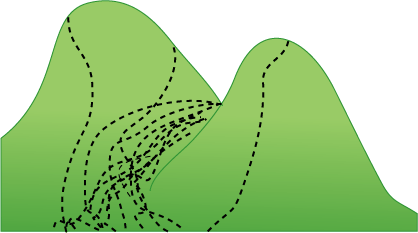Path of least resistance on:
[Wikipedia]
[Google]
[Amazon]
 The path of least resistance is the physical or metaphorical pathway that provides the least resistance to forward motion by a given object or entity, among a set of alternative paths. The concept is often used to describe why an object or entity takes a given path. The way in which water flows is often given as an example for the idea.
The path of least resistance is the physical or metaphorical pathway that provides the least resistance to forward motion by a given object or entity, among a set of alternative paths. The concept is often used to describe why an object or entity takes a given path. The way in which water flows is often given as an example for the idea.
 In
In
 The path of least resistance is the physical or metaphorical pathway that provides the least resistance to forward motion by a given object or entity, among a set of alternative paths. The concept is often used to describe why an object or entity takes a given path. The way in which water flows is often given as an example for the idea.
The path of least resistance is the physical or metaphorical pathway that provides the least resistance to forward motion by a given object or entity, among a set of alternative paths. The concept is often used to describe why an object or entity takes a given path. The way in which water flows is often given as an example for the idea.
Description
 In
In physics
Physics is the natural science that studies matter, its fundamental constituents, its motion and behavior through space and time, and the related entities of energy and force. "Physical science is that department of knowledge which r ...
, the "path of least resistance" is a heuristic from folk physics that can sometimes, in very simple situations, describe approximately what happens. It is an approximation of the tendency to the least energy state. Other examples are "what goes up must come down" ( gravity) and "heat goes from hot to cold" ( second law of thermodynamics). But these simple descriptions are not derived from laws of physics and in more complicated cases these heuristics will fail to give even approximately correct results.
In electrical circuits, for example, the current always follows all available paths, and in some simple cases the "path of least resistance" will take up most of the current, but this will not be generally true in even slightly more complicated circuits. It may seem for example, that if there are three paths of approximately equal resistance, the majority of the current will flow down one of the three paths. However, due to electrons repelling each other, the total path of least resistance is in fact to have approximate equal current flowing through each path. The reason for this is that three paths made of equally conductive wire will have a total resistance that is one-third of the single path. In conclusion, the current is always distributed over all possible paths inversely proportional to their resistance.
The path of least resistance is also used to describe certain human behaviors, although with much less specificity than in the strictly physical sense. In these cases, resistance is often used as a metaphor
A metaphor is a figure of speech that, for rhetorical effect, directly refers to one thing by mentioning another. It may provide (or obscure) clarity or identify hidden similarities between two different ideas. Metaphors are often compared wi ...
for personal effort or confrontation; a person taking the path of least resistance avoids these. In library science and technical writing, information is ideally arranged for users according to the principle of least effort, or the "path of least resistance". Recursive navigation systems are an example of this.
The path of least resistance applies on a local, not global, reference. For example, water always flows downhill, regardless of whether briefly flowing uphill will help it gain a lower final altitude (with certain exceptions such as superfluid
Superfluidity is the characteristic property of a fluid with zero viscosity which therefore flows without any loss of kinetic energy. When stirred, a superfluid forms vortices that continue to rotate indefinitely. Superfluidity occurs in two ...
s and siphons). In physics, this phenomenon allows the formation of potential wells, where potential energy is stored because of a barrier restricting flow to a lower energy state.
See also
* Calculus of variations * Mountain pass theorem *Principle of least action
The stationary-action principle – also known as the principle of least action – is a variational principle that, when applied to the '' action'' of a mechanical system, yields the equations of motion for that system. The principle states tha ...
* Variational principle
In science and especially in mathematical studies, a variational principle is one that enables a problem to be solved using calculus of variations, which concerns finding functions that optimize the values of quantities that depend on those funct ...
* Gradient descent
In mathematics, gradient descent (also often called steepest descent) is a first-order iterative optimization algorithm for finding a local minimum of a differentiable function. The idea is to take repeated steps in the opposite direction of the ...
* Natural lines of drift
* Desire path
A desire path (often referred to as a desire line in transportation planning), also known as a game trail, social trail, fishermen trail, herd path, cow path, elephant path, goat track, pig trail, use trail and bootleg trail, is an unplanned sma ...
References
{{Reflist Calculus of variations it:Meccanica classica#Principio di minima azione